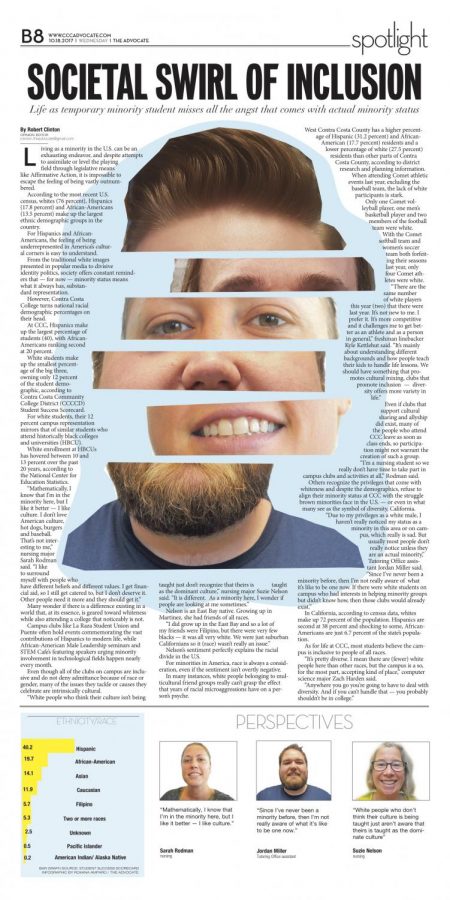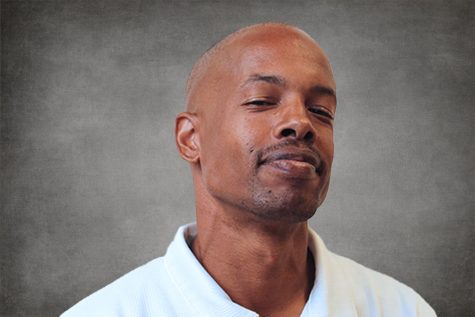Societal swirl of inclusion
Life as temporary minority student misses all the angst that comes with actual minority status
Oct 26, 2017
Living as a minority in the U.S. can be an exhausting endeavor, and despite attempts to assimilate or level the playing field through legislative means like Affirmative Action, it is impossible to escape the feeling of being vastly outnumbered.
According to the most recent U.S. census, whites (76 percent), Hispanics (17.8 percent) and African-Americans (13.5 percent) make up the largest ethnic demographic groups in the country.
For Hispanics and African- Americans, the feeling of being underrepresented in America’s cultural corners is easy to understand.
From the traditional white images presented in popular media to divisive identity politics, society offers constant reminders that — for now — minority status means what it always has, substandard representation.
However, Contra Costa College turns national racial demographic percentages on their head.
At CCC, Hispanics make up the largest percentage of students (40), with African- Americans ranking second at 20 percent.
White students make up the smallest percent- age of the big three, owning only 12 percent
of the student demo- graphic, according to Contra Costa Community College District (CCCCD) Student Success Scorecard.
For white students, their 12 percent campus representation mirrors that of similar students who attend historically black colleges and universities (HBCU).
White enrollment at HBCUs has hovered between 10 and 13 percent over the past 20 years, according to the National Center for Education Statistics.
“Mathematically, I know that I’m in the minority here, but I like it better — I like culture. I don’t love American culture, hot dogs, burgers and baseball.
That’s not interesting to me,” nursing major Sarah Rodman said. “I like to surround
myself with people who have different beliefs and different values. I get financial aid, so I still get catered to, but I don’t deserve it. Other people need it more and they should get it.”
Many wonder if there is a difference existing in a world that, at its essence, is geared toward whiteness while also attending a college that noticeably is not.
Campus clubs like La Raza Student Union and Puente often hold events commemorating the vast contributions of Hispanics to modern life, while African-American Male Leadership seminars and STEM Cafe’s featuring speakers urging minority involvement in technological fields happen nearly every month.
Even though all of the clubs on campus are inclusive and do not deny admittance because of race or gender, many of the issues they tackle or causes they celebrate are intrinsically cultural.
“White people who think their culture isn’t being taught just don’t recognize that theirs is as the dominant culture,” nursing major Suzie Nelson said. “It is different. As a minority here, I wonder if people are looking at me sometimes.”
Nelson is an East Bay native. Growing up in Martinez, she had friends of all races.
“I did grow up in the East Bay and so a lot of my friends were Filipino, but there were very few blacks — it was all very white. We were just suburban Californians so it (race) wasn’t really an issue.”
Nelson’s sentiment perfectly explains the racial divide in the U.S.
For minorities in America, race is always a consideration, even if the sentiment isn’t overtly negative.
In many instances, white people belonging to multicultural friend groups really can’t grasp the effect that years of racial microaggressions have on a per- son’s psyche.
West Contra Costa County has a higher percent- age of Hispanic (31.2 percent) and African-American (17.7 percent) residents and a lower percentage of white (27.5 percent) residents than other parts of Contra Costa County, according to district research and planning information.
When attending Comet athletic events last year, excluding the baseball team, the lack of white participants is stark.
Only one Comet volleyball player, one men’s basketball player and two members of the football team were white.
With the Comet softball team and women’s soccer team both forfeiting their seasons last year, only four Comet athletes were white.
“There are the same number of white players this year (two) that there were last year. It’s not new to me. I prefer it. It’s more competitive and it challenges me to get better as an athlete and as a person in general,” freshman linebacker Cody Tarantino said.
“It’s mainly about understanding different backgrounds and how people teach their kids to handle life lessons. We should have something that pro- motes cultural mixing, clubs that promote inclusion — diversity offers more variety in life.”
Even if clubs that support cultural sharing and allyship did exist, many of the people who attend CCC leave as soon as class ends, so participation might not warrant the creation of such a group.
“I’m a nursing student so we really don’t have time to take part in campus clubs and activities at all,” Rodman said.
Others recognize the privileges that come with whiteness and despite the demographics, refuse to align their minority status at CCC with the struggle brown minorities face in the U.S. — or even in what many see as the symbol of diversity, California.
“Due to my privileges as a white male, I haven’t really noticed my status as a minority in this area or on cam- pus, which really is sad. But usually most people don’t really notice unless they are an actual minority,” Tutoring Office assistant Jordan Miller said. “Since I’ve never been a minority before, then I’m not really aware of what it’s like to be one now. If there were white students on campus who had interests in helping minority groups but didn’t know how, then those clubs would already exist.”
In California, according to census data, whites make up 72 percent of the population. Hispanics are second at 38 percent and shocking to some, African- Americans are just 6.7 percent of the state’s population.
As for life at CCC, most students believe the campus is inclusive to people of all races.
“It’s pretty diverse. I mean there are (fewer) white people here than other races, but the campus is a so, for the most part, accepting kind of place,” computer science major Zach Harden said.
“Anywhere you go you’re going to have to deal with diversity. And if you can’t handle that — you probably shouldn’t be in college.”



